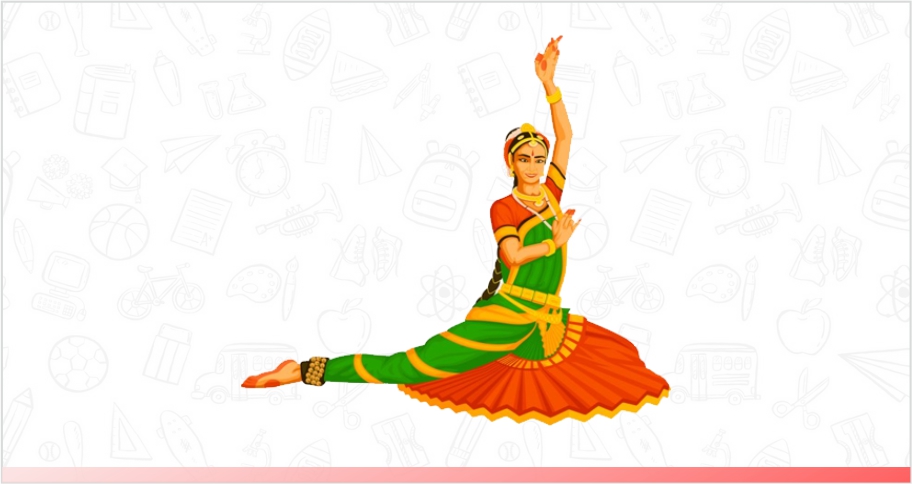Importance of Learning Classical Dance for Kids
By Divya Chopra |
Date 05-09-2023

Admissions Open for
Introduction
Dance is the exercise of the body, mind, and soul. One such dance form that always keeps everyone on its toes, quite literally, is the ballet. To honor the birth of the creator of modern ballet, Jean George Nouverre, the world celebrates International Dance Day on 29th April every year. Ballet is one of the oldest classical dance forms in the world and a very difficult one to master too!
It’s no secret that Indian classical dance has now become world-famous! In fact, Kathak is one of the top 10 popular dance forms to reach a global audience. Bharatnatyam, Odissi, Kuchipudi, Kathakali and Mohiniattam are well-known Indian classical dances, each with their own cultural history and background. The poise, the expressions, the eye movements and the sound of ‘ghungroo’ with the tapping of feet sum up the idea of all Indian classical dances! Not just a sight to behold for the eyes, each of these dances have a huge list of health and behavioral benefits attached to it!

Importance of Learning Classical Dance for Kids
This International Dance Day, let us take a look at the importance of dance and other health benefits of dance to lead a blissful life!
- Patience – Be it any dance form, it teaches you how to be patient and when to be patient. We all know kids these days have so much going on around them that being patient becomes a task in itself. The best way to inculcate the art of patience in them is through dance.
The slow pause in some of the steps in Indian classical dance demands patience not just from the mind, but from the body as well. After a few classes or rehearsals, your kid will be able to observe patience in himself/herself even while breathing!

- Focus – While gearing up for a race in school, one must be aware when to sprint at the same time as hearing the whistle blow. The focus and awareness of a dancer is similar to this. To know and remember the exact timing and tune of the song or music to start dancing, helps in developing focus in your child. It does not happen on day one and that is why patience is often followed by focus. To repeat the same steps for a week or even more than that can be tiring and boring but to have focus on improving one’s rhythm and timing is something worthy to learn. It urges you to stay focused in the present moment. This focus then gets channelised into academics as well – a total win win!

- Discipline – Dance, dance again, dance one more time. Indian classical dance, unlike other dance forms, cannot be taught a lot in one day. Every move, expression and pause between two steps require what we all are trying to achieve in life – perfection. To practice what’s learnt in front of the teacher at home and keep polishing the movements develop discipline in your child’s life. Moreover, somewhere on a path of perfecting the timing of steps to match it with the rhythm of music teaches the importance of time management and its utilization in other areas of your kid’s life too!

- Flexibility – This requires no explanation. Various body movements and gestures are a great way to develop flexibility in your child’s body from a young age! Indian classical dances involve a lot of half-sitting or squatting positions which improve the flexibility of your muscles around the pelvis and thighs, straightening the spinal cord as well!

- Cultural insight – As mentioned earlier, each of these dance forms have their own cultural background attached to them. Hand gestures and signs used in the dance have a different meaning. Originating from such culturally rich lands of Karnataka, Tamil Nadu, Odisha, etc., the dance formations tell a historical tale, often linked to the Gods, teaching kids about the long-lost cultural heritage of India!

- Full body coordination – Eye, hand, legs, torso, mind all of these work together in unison to create a great Indian classical dance performance! It doesn’t just teach full-body coordination but also helps your kid develop and maintain body balance which is an important asset to have to perform other physical activities as well!

Conclusion
Dance is not just moving your hands and legs to match the tune of a song. It’s a lot more than that! To learn the rhythm of the steps being performed, one just might learn the rhythm of everything else in life! A child will learn to understand the capacities of his or her own body, maintain a balance between the mind, the body and feelings and to channel it out in a positive and expressive way. They not just learn to express themselves but also present themselves as confident and sound human beings.
So, what are you waiting for? Encourage your kids to try out any one or all of these popular Indian classical dance forms on this International Dance Day and watch them unfold their hidden abilities on the count of five, six, seven, eight!
Also Read:
Connecting with Kids When You’re Exhausted
CBSE Schools In Popular Cities
- CBSE Schools in Bangalore
- CBSE Schools in Mumbai
- CBSE Schools in Pune
- CBSE Schools in Hyderabad
- CBSE Schools in Chennai
- CBSE Schools in Gurgaon
- CBSE Schools in Kolkata
- CBSE Schools in Indore
- CBSE Schools in Sonipat
- CBSE Schools in Delhi
- CBSE Schools in Rohtak
- CBSE Schools in Bhopal
- CBSE Schools in Aurangabad
- CBSE Schools in Jabalpur
- CBSE Schools in Jaipur
- CBSE Schools in Jodhpur
- CBSE Schools in Nagpur
- CBSE Schools in Ahmednagar
- CBSE School In Tumkur

Call Us to know more about Orchids
Swipe Up



.jpg&w=1920&q=80)












